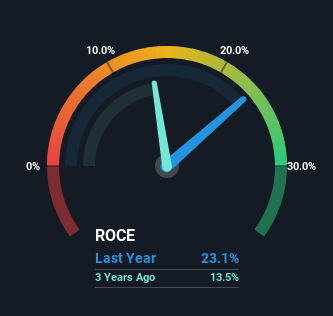- United Kingdom
- /
- Wireless Telecom
- /
- LSE:AAF
We Like Airtel Africa's (LON:AAF) Returns And Here's How They're Trending

What trends should we look for it we want to identify stocks that can multiply in value over the long term? Firstly, we'll want to see a proven return on capital employed (ROCE) that is increasing, and secondly, an expanding base of capital employed. If you see this, it typically means it's a company with a great business model and plenty of profitable reinvestment opportunities. With that in mind, the ROCE of Airtel Africa (LON:AAF) looks great, so lets see what the trend can tell us.
Return On Capital Employed (ROCE): What Is It?
For those that aren't sure what ROCE is, it measures the amount of pre-tax profits a company can generate from the capital employed in its business. Analysts use this formula to calculate it for Airtel Africa:
Return on Capital Employed = Earnings Before Interest and Tax (EBIT) ÷ (Total Assets - Current Liabilities)
0.23 = US$1.8b ÷ (US$11b - US$3.6b) (Based on the trailing twelve months to March 2023).
So, Airtel Africa has an ROCE of 23%. That's a fantastic return and not only that, it outpaces the average of 8.9% earned by companies in a similar industry.
View our latest analysis for Airtel Africa

In the above chart we have measured Airtel Africa's prior ROCE against its prior performance, but the future is arguably more important. If you're interested, you can view the analysts predictions in our free report on analyst forecasts for the company.
SWOT Analysis for Airtel Africa
- Earnings growth over the past year exceeded the industry.
- Debt is not viewed as a risk.
- Dividends are covered by earnings and cash flows.
- Earnings growth over the past year is below its 5-year average.
- Dividend is low compared to the top 25% of dividend payers in the Wireless Telecom market.
- Annual earnings are forecast to grow faster than the British market.
- Good value based on P/E ratio and estimated fair value.
- Revenue is forecast to grow slower than 20% per year.
So How Is Airtel Africa's ROCE Trending?
The trends we've noticed at Airtel Africa are quite reassuring. Over the last five years, returns on capital employed have risen substantially to 23%. The amount of capital employed has increased too, by 99%. So we're very much inspired by what we're seeing at Airtel Africa thanks to its ability to profitably reinvest capital.
In another part of our analysis, we noticed that the company's ratio of current liabilities to total assets decreased to 32%, which broadly means the business is relying less on its suppliers or short-term creditors to fund its operations. So shareholders would be pleased that the growth in returns has mostly come from underlying business performance.
The Bottom Line On Airtel Africa's ROCE
All in all, it's terrific to see that Airtel Africa is reaping the rewards from prior investments and is growing its capital base. And with a respectable 88% awarded to those who held the stock over the last three years, you could argue that these developments are starting to get the attention they deserve. Therefore, we think it would be worth your time to check if these trends are going to continue.
Airtel Africa does have some risks though, and we've spotted 1 warning sign for Airtel Africa that you might be interested in.
High returns are a key ingredient to strong performance, so check out our free list ofstocks earning high returns on equity with solid balance sheets.
New: Manage All Your Stock Portfolios in One Place
We've created the ultimate portfolio companion for stock investors, and it's free.
• Connect an unlimited number of Portfolios and see your total in one currency
• Be alerted to new Warning Signs or Risks via email or mobile
• Track the Fair Value of your stocks
Have feedback on this article? Concerned about the content? Get in touch with us directly. Alternatively, email editorial-team (at) simplywallst.com.
This article by Simply Wall St is general in nature. We provide commentary based on historical data and analyst forecasts only using an unbiased methodology and our articles are not intended to be financial advice. It does not constitute a recommendation to buy or sell any stock, and does not take account of your objectives, or your financial situation. We aim to bring you long-term focused analysis driven by fundamental data. Note that our analysis may not factor in the latest price-sensitive company announcements or qualitative material. Simply Wall St has no position in any stocks mentioned.
About LSE:AAF
Airtel Africa
Provides telecommunications and mobile money services in Nigeria, East Africa, and Francophone Africa.
High growth potential slight.


